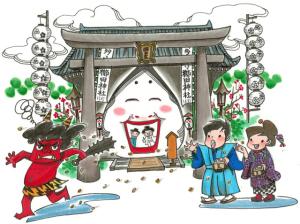Hakata Culture vol.72
Setsubun-Heralding the Coming of Spring

Celebrated throughout Japan on Feb. 3, Setsubun is the day when people throw beans and chant "Out with the devil! In with luck!" to drive bad luck out of their homes. Fukuoka is famous for the Hakata Setsubun Festival held at Kushida Shrine. To enter the shrine, you must walk through the mouth of the largest otafuku ("smiling woman") mask in Japan, which is thought to bring good luck and prosperity in business. Once inside, visitors can enjoy devils dancing and people born under the current Zodiac sign throwing beans.
February is also one of two months in the year when the Grand Kabuki is held at Hakataza, and appearances by the kabuki actors at the shrine serve to liven up the Setsubun Festival. The actors kick off the celebrations with a parade down Kawabata Shopping Street from Hakataza to Kushida Shrine. The Setsubun Festival at Kushida Shrine is said to have begun in the late Edo Period as a lavish ceremony in which people prayed for protection from evil spirits.
There is also a Setsubun Festival held at nearby Tochoji Temple. A special stage is installed in front of the main building, and people dressed as the Seven Gods of Good Fortune and otafuku vigorously scatter beans into the crowd. This is also one of only three days a year when visitors are allowed to view the multi-armed Kannon statue, which is designated as an important cultural asset. Created in the Heian Period, the statue is only 87 cm tall, but the craftsmanship is exquisite.
The word setsubun originally refers to four different days, that is, the eve of the first day of each season in the lunar calendar (The two kanji literally mean "seasonal division"). People used to think that evil spirits ("devils") would come out when the seasons changed, so they started holding ceremonies to drive them away. The tradition of throwing beans dates back to a Heian Period Chinese court custom for warding off spirits. Setsubun gradually changed over the generations, and since the Edo Period, it has come to refer to the day before the first day of spring on the lunar calendar (around Feb. 4).
新しい季節の到来を告げる節分
「鬼は外、福は内」と言いながら、豆まきをして邪気を払う節分。2月3日に全国各地で行われる行事です。博多で有名なのは櫛田神社の「博多節分」。日本一の大きな「おたふく面」が飾られ、この門をくぐると福が来て商売繁盛につながるという言い伝えもあります。多くの参拝客でにぎわう境内では、年男や年女による豆まきが行われ、鬼たちの鬼踊りなども見られます。
毎年2月はちょうど博多座で歌舞伎が行われる時期でもあります。櫛田神社の節分祭には、2月歌舞伎に出演する歌舞伎役者も登場して華やかな雰囲気です。博多座と櫛田神社をつなぐ川端商店街でも、歌舞伎役者たちが練り歩いて節分を祝います。櫛田神社の節分祭は、江戸時代末期から厄除け祈願のお祭りとして盛大に行われていたそうです。
櫛田神社からほど近い東長寺でも節分祭が行われます。本堂前には特設舞台が設けられ、縁起の良い七福神やお多福が登場して勢いよく豆をまきます。また、この日は年3回しか公開されない重要文化財・千手観音が見られる日でもあります。平安時代に作られた観音像は高さ87センチと小さいながらも見事な出来栄えです。
節分という言葉は、もともと季節の変わり目である立春・立夏・立秋・立冬の前日を指す言葉でした。漢字の通り、「季節を分ける」ことを意味しているのです。季節の変わり目には邪気(鬼)が生じると考えられており、それを払うために儀式が行われるようになりました。豆まきなどの風習は平安時代に中国から伝わった追儺(ついな)という宮中儀式が元になっています。節分は時代とともに変遷し、江戸時代以降は特に立春(毎年2月4日ごろ)の前日を指す行事となったそうです。

